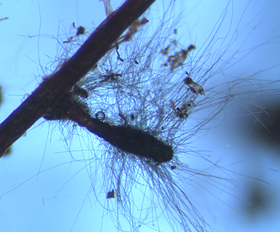The role of effector-like small secreted proteins (SSP) in the formation and functioning of Cenococcum geophilum ectomycorrhizas (ECM)
PI : Annegret Kohler (UMR 1136 – Joint Research Unit for Tree/Microorganism Interactions – IAM)
Co-applicants : Martina Peter (Forest, Snow and Landscape Research — WSL, Birmensdorf, Switzerland)
Collaborations :
Claire Veneault-Fourrey (IAM)
______________________________________________________________________________
Context — In nature, soil-born fungi associate with roots of trees to form ectomycorrhizas (ECM). In exchange for carbohydrates, ECM fungi improve mineral supply of host trees, protect them against stresses such as drought and directly contribute to the exclusion of competitive microbes. In order for mycorrhizal fungi to form intimate intracellular contacts with living plant cells, they manipulate host defenses and metabolism. Recent studies have highlighted the fact that mycorrhizal fungi, similar to pathogens, use small secreted proteins (SSPs) as molecular keys to promote symbiosis.
Objectives —The main goal of this project is to elucidate the role of effector-like SSPs in the mycorrhiza formation and functioning of the ecologically important species Cenococcum geophilum by using available genomic and transcriptomic resources.
Approaches — We will (i) conduct an in-depth genome-wide survey of SSPs in C. geophilum by mining available gene expression data to identify candidate effectors, (ii) will use re-sequenced C. geophilum strains and closely related dothideomycetous genomes to study intra- and interspecific diversity in the sequences of the candidate effectors to illustrate their evolution and conservation and (iii), to functionally characterize a few selected candidate effectors through a) gene expression validation, b) localization experiments, and c) null-mutants construction.
Expected results and impacts — This project aims to understand the genetic basis of molecular communication occurring between common coniferous tree species (Scotts pine, Norway spruce) or deciduous tree species widely planted around the globe (Poplars) and their ECM fungal symbiont C. geophilum. Understanding the physical, molecular, and chemical interfaces between trees and microorganisms is a key element to determining their functional roles in biological and environmental systems and the impact of environmental changes onto these finely balanced interactions.



